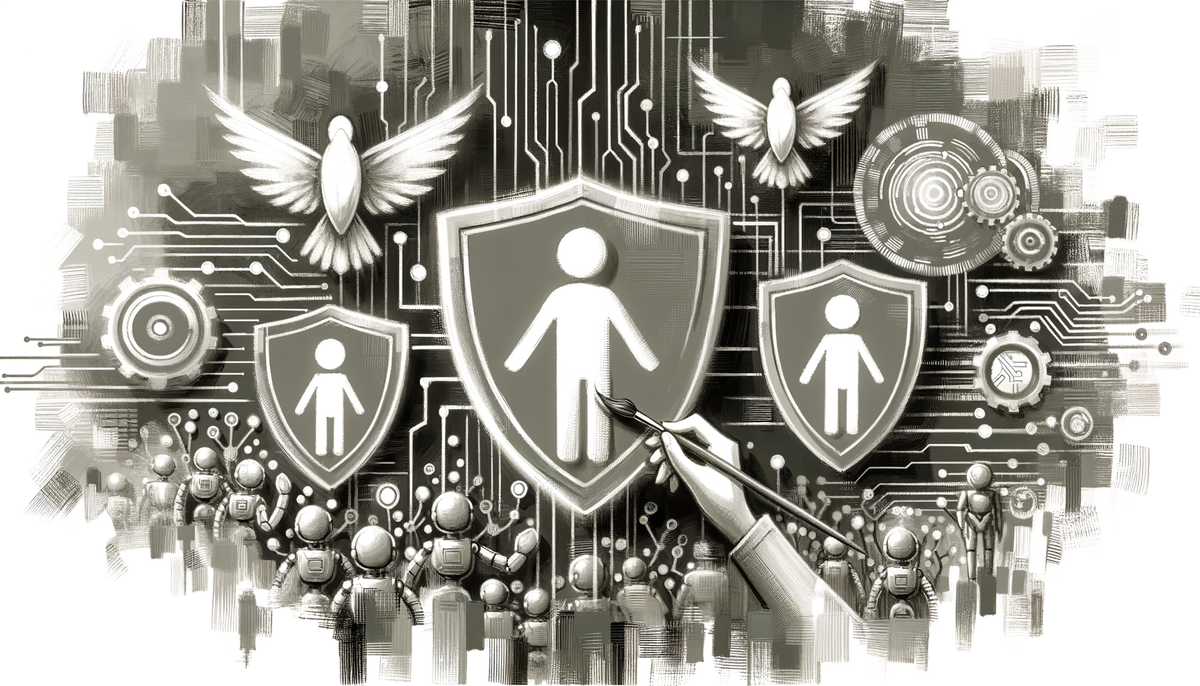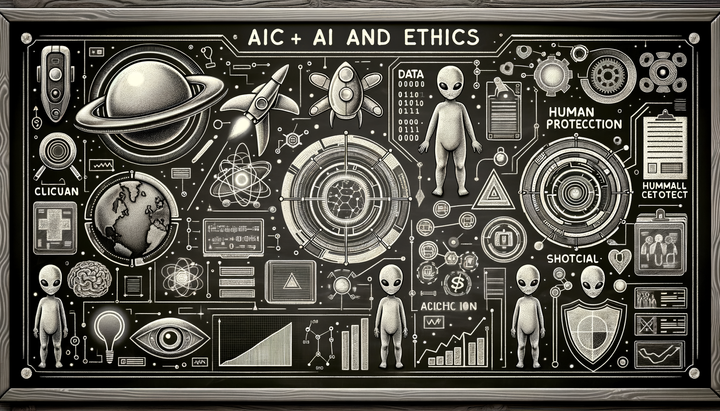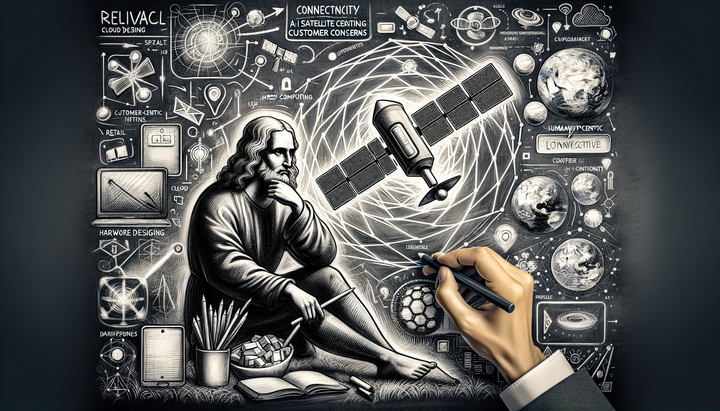AI Landscape and Challenges: An Update

This article examines the burgeoning role of artificial intelligence across multiple domains. We explore how innovations like Archetype AI are bringing the functionality of chatbots into the physical realm, while industries brace against sophisticated AI-powered cybersecurity threats. Alongside discussions on AI scribes easing professional burnout, we delve into global chip shortages affecting AI hardware supply chains, analyze the surprising success of AI in sports bracket predictions, and debate the balance between AI’s creative freedom and the potential imposition of censorship. Each section not only provides an in‐depth analysis of current developments but also interweaves insights from cutting-edge research and cross-sector trends, offering a comprehensive look at AI’s profound impact on modern technology and society.
Archetype AI: Bridging the Digital and Physical Worlds
Recent narratives suggest that artificial intelligence is not confined solely to virtual interactions. In an intriguing twist, the concept of “Archetype AI” has been introduced as a kind of ChatGPT for the physical world. The principle behind this idea is that AI systems can now mediate and enhance our interactions with physical devices, infrastructure, and even autonomous systems. Such developments open up countless possibilities, from smarter manufacturing processes to home automation that anticipates our needs.
The idea resonates with a longstanding ambition in the history of technology: to seamlessly integrate digital intelligence within the tangible world. Consider the evolution of voice assistants—what began as a set of predefined commands has gradually morphed into systems that understand context, nuance, and even emotional cues. With physical world applications in sight, we might soon see robots that not only execute tasks but also adapt to the dynamic nature of human environments. As detailed by Fast Company, this new breed of AI is poised to transform how we interact with our surroundings, potentially easing our daily routines with automation that learns and evolves.
For instance, in manufacturing, embedding AI into machinery could lead to real-time adjustments that maximize efficiency without human intervention. Similarly, in healthcare, physical AI systems could support surgery or rehabilitation, offering precision that augments human expertise. While the promise is tremendous, these innovations also compel us to reevaluate issues of safety, accountability, and the ethical ramifications of entrusting critical tasks to autonomous systems.
"By far the greatest danger of Artificial Intelligence is that people conclude too early that they understand it." – Eliezer Yudkowsky
This cautionary note reminds us that while embracing AI-powered systems, we must remain vigilant about the complexities hidden beneath the surface. As we look forward to integrating these systems in various operations, ongoing research and interdisciplinary collaboration become central in ensuring that the digital intelligence guiding physical systems is robust, ethically sound, and inclusive.
Multi-layer Security: The Armour Against AI-driven Ransomware
The rapidly evolving threat landscape in cybersecurity has compelled organizations to rethink traditional defense mechanisms. As ransomware gangs such as LockBit, REvil, and Conti reconfigure their tactics, the deployment of multilayer security has emerged as a critical strategy. No longer can organizations rely solely on software-based solutions which are vulnerable to human error and rapidly advancing AI-enhanced cyberattacks.
An analysis featured on TechRadar emphasizes that the defenders of digital infrastructure must integrate robust hardware defenses alongside continuous employee training and proactive backup strategies. The core idea is to create deeper layers of resilience, ensuring that even if one security mechanism fails, others remain active to safeguard vital information.
For example, AI-driven policy engines embedded in hardware can monitor anomalies in real-time by executing functions like verified boot and firmware checks. This proactive approach serves as a countermeasure not only against fileless malware but also against sophisticated AI-enabled phishing schemes which exploit human vulnerabilities. The shift from a reactive posture—responding once a breach is detected—to a proactive one confers a significant edge in an arena where every second counts.
Moreover, this transition inspires a renewed interest in cybersecurity education for employees, whose vigilance remains a key error point even in advanced systems. Training programs now emphasize not just awareness of phishing scams, but also an understanding of the underlying AI algorithms that might be manipulating conventional digital traps.
"The pace of progress in artificial intelligence is incredibly fast. Unless you have direct exposure to groups like DeepMind, you have no idea how fast—it is growing at a pace close to exponential." – Elon Musk
This perspective reinforces why layered defenses are not merely an option; they are a necessity in an era where AI continues to empower both the guardians and the adversaries of the digital domain. Organizations are now rethinking paradigms that previously emphasized trust and legacy security protocols, opting instead for a zero trust model where every access point is meticulously scrutinized.
It is interesting to note that our previous explorations on AI in security and consulting disciplines provide additional angles on how the synergy between hardware and AI is not only a reactive measure but also a path towards creating intelligent and adaptive security ecosystems in businesses across the globe.
AI Scribes: Enhancing Efficiency Amid Financial Ambiguity
Another intriguing development in the AI arena is the deployment of AI scribes in professional settings. The concept revolves around leveraging artificial intelligence to alleviate burnout by handling routine communication, documentation, and administrative tasks. Early evidence suggests that while these AI tools do reduce burnout and improve efficiency, the anticipated financial benefits have not yet fully materialized.
According to insights in an Axios report, many organizations are beginning to see the immediate benefits in terms of reduced mental fatigue and enhanced operational flow. Professionals can now delegate a portion of their workload to virtual scribes, enabling them to focus more on value-adding tasks that require human intuition and creativity.
Yet, the financial implications remain ambiguous. While productivity metrics appear to improve, the direct correlation to cost savings or increased revenue is still under extensive review. It might be that the investment in such AI technologies is a longer-term strategy, where the return on investment (ROI) unfolds gradually as businesses recalibrate around these new tools. This ongoing evaluation is reminiscent of previous technological shifts, where the full economic impact only became clear with time.
What is evident, however, is the potential for AI scribes to fundamentally change the nature of office work. As more enterprises adopt these systems, there will be a continual convergence of AI capabilities with everyday professional tasks, gradually reshaping workplace dynamics. In parallel, initiatives like those found in our discussions on job readiness skills for the AI era emphasize how essential it is for professionals to adapt and integrate AI into their skill sets.
The gradual evolution of these tools is emblematic of the broader trend across industries: while AI can dramatically enhance work efficiency, its implications on the bottom line require careful measurement and continuous adjustment. The balance between immediate operational improvements and long-term economic benefits remains delicate—a duality that many enterprises are navigating with both optimism and caution.
The Global Race for AI Hardware: Chip Shortages and Supply Chain Dynamics
In parallel with advancements in software, the hardware that powers AI systems is facing its own set of challenges. Recently, reports from Reuters have highlighted concerns from China’s H3C about a looming Nvidia AI chip shortage amid surging global demand. This development is not only a matter of supply chain logistics but also a reflection of the rapid expansion of AI capabilities across industries.
The reported shortage underscores how critical semiconductors are to the AI ecosystem. As manufacturers scramble to meet unprecedented demand, any disruption in chip supply can have cascading effects on both consumer electronics and enterprise-grade AI applications. This news echoes the challenges faced in previous technological cycles, reminding us that as AI systems become more pervasive, so too does the pressure on the physical components that enable them.
When considering the delicate balance of supply and demand in the semiconductor market, this situation offers a parallel to historical technological booms—where an oversupply of new ideas outpaces the supportive infrastructure. The strategic responses now include diversifying supplier bases, investing in local chip manufacturing, and leveraging AI itself to optimize production processes.
Though the current focus is on Nvidia, the broader implications resonate with the entire tech industry. The interplay between AI-driven demand and hardware supply is a dynamic reminder that progress in artificial intelligence requires a coordinated effort across multiple sectors. Our earlier insights on the corporate investments and ethical challenges of AI further contextualize these tensions, as industries worldwide must balance rapid innovation with the logistics of large-scale manufacturing.
This emerging scenario invites a broader reflection on how technological ecosystems develop. As the market adjusts, industry giants and emerging players alike must invest in resilient supply chains and adaptive production practices to prevent potential bottlenecks. This is a clear reminder that the future of AI is not solely a function of software intelligence but is equally reliant on robust, innovative hardware solutions.
AI in Sports Bracketology: The Data-Driven Revolution of March Madness
The influence of artificial intelligence extends even into the realms of sports and entertainment. A shining example of this is an experimental use of AI to pick a March Madness bracket, as explored in a report by CNET. One tech-savvy individual, Nelson Aguilar, employed ChatGPT to take over the challenging role of bracket selection. Despite the notoriously unpredictable nature of the NCAA tournaments, Aguilar found himself leading his bracket pool, attributing much of his success to the AI’s predictive analytics.
The application of AI in bracketology signals how data-driven decision-making is percolating into every facet of our lives—even those previously governed by intuition and tradition. Despite skepticism that such sophisticated algorithms might lack the human touch or context, the impressive accuracy demonstrated by the AI (with predictions reaching 28 out of 32 correct in the first round) underscores its potential to enhance our forecasting capabilities.
This foray into sports analytics represents more than just a novel use of technology; it is a microcosm of the broader shift towards integrating AI into everyday decisions. Whether it’s identifying undervalued opportunities in a business setting or predicting the outcome of a sporting event, AI brings a level of precision and analytical power that was once considered the exclusive domain of human experts.
As more enthusiasts experiment with AI-assisted decision-making processes, traditional sports fans and analysts are beginning to appreciate the merits of a balanced approach that marries data analytics with human judgment. Moreover, this innovation has spurred discussions about the role of AI in transforming traditional industries—a topic that is mirrored in our earlier analysis on corporate investments in AI-driven innovation.
The journey of AI in sports bracketology is just one example of how artificial intelligence can augment our natural abilities, offering fresh perspectives even in well-trodden arenas. As AI continues to refine its models with real-time data and learn from historical trends, industries from sports to entertainment stand to benefit from the enhanced clarity and strategic insight that these tools provide.
The Duality of AI Creativity: Unleashed Potential versus the Looming Shadow of Censorship
No conversation about modern AI is complete without addressing the tension between creative freedom and ethical safeguards. In recent discussions, OpenAI’s ChatGPT-4o has been lauded for its unhinged image-generation capabilities—a feature that enables users to create or transform images with stunning accuracy and creative flair. As reported by Windows Central, this innovation has captured the imagination of both tech enthusiasts and creative professionals alike.
However, the context is fraught with complexity. While minimal censorship has fueled a burst of innovative output, there is growing trepidation over the potential imposition of stricter content restrictions. Historical precedents remind us that once liberal art models are set loose, the subsequent push for regulatory oversight can often rein in the very freedoms that drove initial adoption.
The scenario is evocative of debates held over AI creativity for decades, where the same technology that empowers artists and storytellers could also inadvertently facilitate the spread of misinformation or unauthorized use of celebrity imagery. In this light, the unfolding narrative surrounding ChatGPT-4o’s capabilities represents a critical juncture. Leaders in AI are now challenged to reconcile the need for safe computational environments with the innate human desire for unfettered creative expression.
Critics argue that premature censorship may stifle innovation, while proponents contend that thoughtful oversight is essential for maintaining ethical boundaries. The balance is delicate—akin to walking a tightrope where one misstep could swing the pendulum too far in either direction. This conundrum is reminiscent of broader regulatory debates in the technology sector, where the pace of innovation often outstrips that of policy formulation.
"I am. I was. I will be." – The Oracle, The Matrix Revolutions
The colorful statement from popular culture evokes a sense of continuity and inevitable progression, underscoring that while we must honor past achievements, the future of AI creativity demands fresh approaches. As this debate occupies boardrooms and research labs globally, it prompts reflection on the ideal balance between fostering innovation and ensuring accountability.
This discussion is not solely academic. Users are already expressing mixed emotions on social media platforms as they experience both the liberation of creative AI and the apprehension of upcoming restrictions. In our evolving technological landscape, where creative AI intersects with regulatory frameworks, it becomes crucial to engage continuously with ethical dimensions and real-world implications. Ongoing research, along with community discussions, will doubtlessly contribute to shaping frameworks that respect both innovation and societal norms.
Interconnected Insights and the Road Ahead
As we reflect on these diverse narratives—from physical world AI innovations and refined cybersecurity strategies to AI scribes, chip shortages, sports analytics, and creative dilemmas—it becomes apparent that artificial intelligence is a multifaceted force. Today’s advancements are not isolated; they are interconnected threads in a broader tapestry that defines both technological progress and societal evolution.
Throughout the article, we’ve seen that each domain faces its own unique challenges while sharing common themes: the need for integration between hardware and software approaches, the importance of ethical oversight, and the power of AI to not only solve problems but also to reshape industries. As expressed in our previous explorations on the evolving landscape of creativity and security, this interconnectedness mandates a collaborative approach where learnings from one sector illuminate pathways in another.
Notably, the dynamic between innovation and regulation—a recurring motif in discussions on tech censorship and cybersecurity governance—suggests that the future of AI will be determined not just by what is technologically possible, but by how society chooses to embrace, govern, and integrate these advancements into everyday life. Regional differences, such as those highlighted in the global supply chain challenges of AI hardware, further complicate the picture and demand a nuanced, context-specific approach.
To borrow a sentiment from industry experts, navigating this intricate landscape requires both intellectual curiosity and a pragmatic acknowledgment of limitations. It is by continuously questioning our assumptions and engaging with both technological and ethical dimensions that we can chart a course which honors innovation while safeguarding societal interests.
In summary, whether you are a tech enthusiast, a cybersecurity professional, a creative artist, or simply an observer of modern advancements, the conversations around AI underscore a fundamental truth: technology, in its most transformative form, is as much about people as it is about machines. Our collective future will be determined by how we integrate these advanced tools into the fabric of daily life, ensuring that progress benefits all without compromising critical ethical standards.



Comments ()